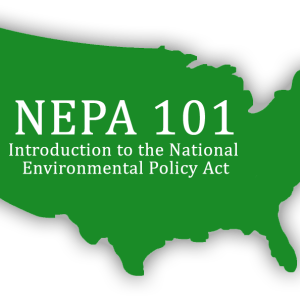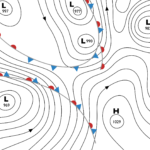
What is NEPA?
The National Environmental Policy Act (NEPA) is one of the shortest laws to exist and is less than 6 pages in length. NEPA was passed by Congress in 1969, signed into law on January 1, 1970 by President Richard Nixon and set the stage for environmental policy for the United States (1). Environmental policy has grown into a career path since the implementation of NEPA. NEPA applies to all federal agencies and their actions. Actions have a wide definition and this can include regulations, policies, projects, licensing and permitting. There was not a consistent standard for documenting the decision making process, considering environmental effects on a project or inclusion of the public in the process prior to NEPA. In fact, it was unclear how public decisions were made and the public was informed after the fact more often than not. This law was a turning point where the country takes a balanced approach to major decision-making including providing the public with a proactive voice in the process. NEPA establishes a baseline standard and requires all federal agencies to take a “hard look” at how their actions affected the human and natural environment and if there are ways to minimize environmental effects (2). It also created the Council for Environmental Quality (CEQ) that is responsible for overseeing NEPA implementation. It should be emphasized that NEPA does not dictate the programs or actions taken but to make prudent decisions after studying potential environmental effects. Multiple states such as California, New York and Florida have state laws equivalent to NEPA. The state environmental process covers actions that do not fall under the jurisdiction of the federal NEPA process.
What Are the Main Components of the NEPA Process?
Each agency will have their own specialized process that is followed for their actions but they all have the same general process. The overall NEPA process is to identify the issue that needs to be addressed, determine alternatives that would correct the problems identified, study any potential environmental issues using various established methods, comply with any environmental regulations, involve the pubic throughout the process and document the decisions made in a NEPA document. NEPA documents are divided into three categories or classes. If the action is anticipated to have or potentially have significant environmental impacts or if there is significant public controversy, then an Environmental Impact Statement (EIS) will be prepared. If it is unclear if the anticipated impacts will be significant, then an Environmental Assessment (EA) will be prepared. If the EA indicates there will be significant environmental impacts, then an EIS will need to be prepared. The federal agency leading the process will approve a final finding based on the information within the NEPA document. The findings are called a Record of Decision (ROD) for an EIS and a Finding of No Significant Impact (FONSI) for an EA (3). If no significant environmental impacts are anticipated or if it has been determined that certain actions in the past have not resulted in significant environmental impacts, then they will be Categorically Excluded (CE or Catex) from the detailed analysis required for an EIS. Categorically Excluded actions still comply with environmental regulations and involve the public. The CE process is streamlined to correlate with the environmental impacts anticipated. The equivalent state regulations have a similar process that mirrors the federal process in many aspects. State processes are highly customized and change with greater frequency than the federal process but they are easily accessible on their websites.
What Are the Roles and Responsibilities Associated with NEPA?
There is a lead federal agency associated with an action. This is usually determined through jurisdictional authority specified within regulations. There are times when more than one federal agency may join forces as joint leads. For example, FHWA is the lead federal agency for road transportation projects, the Bureau of Land Management (BLM) is the lead federal agency for project on National Conservation Lands and the Federal Energy Regulatory Commission (FERC) is the lead federal agency for oil and gas projects. The actual NEPA process may be completed by another entity such as a state agency or private company (applicant) and submit the final NEPA document to the lead federal agency for review and approval.
A cooperating agency has the expertise with local environmental concerns and may have local jurisdictional authority. These can include state agencies, Metropolitan Planning Organizations (MPO), counties, cities or others designated by law (e.g. toll road authority). The cooperating agencies provide information and guidance as early in the process as possible. Cooperating agencies may be those with authority and responsibility to ensure environmental regulations are met such as the Clean Water Act, Clean Air Act, hazardous materials regulations or Section 106 for cultural resources (historic and archaeology). These can include Tribal organizations, State Historic Preservation Officer (SHPO), State Department of Natural Resources or State Department of the Environment.
The public has a huge role in the NEPA process. They provide input throughout the process from the early scoping phase to participating at public outreach activities such as meetings. The lead agency must take all comments received from the public into consideration before making a decision. A great resource for the public is the Citizens Guide to NEPA , which can be found on CEQ's website at NEPA.gov.
The Environmental Protection Agency (EPA) has a unique role in the NEPA process. They have an agreement with CEQ where they are responsible for carrying out the administrative process of filing EIS documents. The EPA receives all EIS documents and has a publically accessible database to track them.
The CEQ serves multiple roles including a mediator when federal agencies have a dispute regarding an action. CEQ prepares guidance and policies based on study of environmental trends and associated research.
Where Can I Find More Information and What Can I Do to Become Involved?
The NEPA process does not work without active involvement from you. Attend public meetings and public hearings in your area. Join or participate in local Citizen Action Committees (CAC). Get to know your local government and the local planning process.
Resources are readily available for everybody from the beginner to the professional. Some examples are:
- CEQ's website provides a wealth of information.
- Project specific EIS documents can be found on the EPA's EIS database.
- Federal environmental information can be found at whitehouse.gov
- The Environmental Law Institute (ELI) has great resources for the public and environmental professional.
- The federal website gov provides an extensive list of contacts that is useful considering the NEPA process differ between federal agencies. The list includes federal, state and local contacts.
- CEQ provides a list of federal NEPA websites.
Sources Cited
- http://www.eli.org/land-biodiversity/national-environmental-policy-act-nepa
- http://www.npi.org/NEPA/process
- http://www.epa.gov/compliance/nepa/
Sources Used for Research
- http://www.gsa.gov/portal/content/104676
- http://www.epa.gov/compliance/nepa/
- http://www.gpo.gov/fdsys/granule/CFR-2011-title40-vol33/CFR-2011-title40-vol33-part-id1102/content-detail.html
- http://www.ecfr.gov/cgi-bin/text-idx tpl=/ecfrbrowse/Title40/40cfr1500_main_02.tpl
- http://www.ecfr.gov/cgi-bin/text-idx?tpl=/ecfrbrowse/Title40/40cfr1501_main_02.tpl
- http://www.ecfr.gov/cgi-bin/text-idx?tpl=/ecfrbrowse/Title40/40cfr1502_main_02.tpl
- http://www.ecfr.gov/cgi-bin/text-idx?tpl=/ecfrbrowse/Title40/40cfr1503_main_02.tpl
- http://www.ecfr.gov/cgi-bin/text-idx?tpl=/ecfrbrowse/Title40/40cfr1504_main_02.tpl
- http://www.ecfr.gov/cgi-bin/text-idx?tpl=/ecfrbrowse/Title40/40cfr1505_main_02.tpl
- http://www.ecfr.gov/cgi-bin/text-idx?tpl=/ecfrbrowse/Title40/40cfr1506_main_02.tpl
- http://www.ecfr.gov/cgi-bin/text-idx?tpl=/ecfrbrowse/Title40/40cfr1507_main_02.tpl
- http://www.ecfr.gov/cgi-bin/text-idx?tpl=/ecfrbrowse/Title40/40cfr1508_main_02.tpl
- Cultural Resources 101: Part of the Federal Environmental Process - March 8, 2015
- Introduction to Environmental Finance - January 26, 2015
- Indoor Air Quality and Environmental Health - December 21, 2014
Related Articles
Featured Article

Big Data: Explaining its Uses to Environmental Sciences





